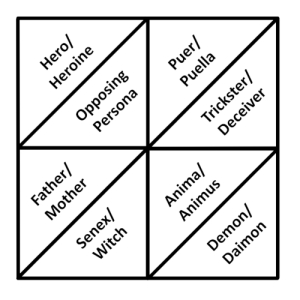 Jung’s diagram of his alchemical tetrameria is supposed to represent the evolving self, and suggests movement, succession, and change and yet stillness, consistency, and renewal. His own diagram is quite different from mine, but I do think that mine has some merit.
Jung’s diagram of his alchemical tetrameria is supposed to represent the evolving self, and suggests movement, succession, and change and yet stillness, consistency, and renewal. His own diagram is quite different from mine, but I do think that mine has some merit.
What are those elements A, B, C, D, and a, b, c, d, and the subscripts 1, 2, 3, 4, indicating the modification of them? I’m not quite sure that it matters, except that for the relationships between the two, and the relationships between the four squares, and the relationships between the four parts of the four squares.
In Jung’s diagram, A equals a cycle of a, b, c, and d, and likewise B a cycle of a1, b1, c1, and d1, etc., and so we can instead say A is a cycle of Aa, Ab, Ac, and Ad, and likewise B is a cycle of Ba, Bb, Bc, and Bd, etc. In that sense my diagram denotes much the same as Jung’s.
Nevertheless, I’m going to have to cycle through some more thoughts about why one should spend too much time contemplating this diagram.
Further Reading:
https://elements.spiritalchemy.com/t3-Ch3.html
http://finitegeometry.org/sc/ph/imago.html
http://www.log24.com/philo/Jung/Aion14.html
Murray Stein / Jung’s Map of the Soul: an introduction
Leslie Stein / Becoming Whole: Jung’s equation for realizing God
Carl Jung / Aion
[*12.10, *12.11]
<>











